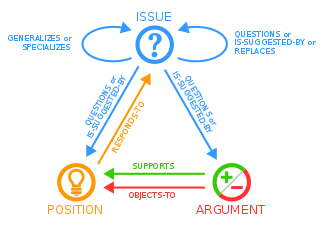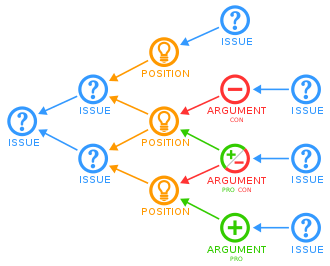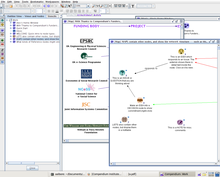 |
| Information mapping |
|---|
| Topics and fields |
| Node–link approaches |
|
| See also |
The issue-based information system (IBIS) is an argumentation-based approach to clarifying wicked problems—complex, ill-defined problems that involve multiple stakeholders. Diagrammatic visualization using IBIS notation is often called issue mapping.
IBIS was invented by Werner Kunz and Horst Rittel in the 1960s. According to Kunz and Rittel, "Issue-Based Information Systems (IBIS) are meant to support coordination and planning of political decision processes. IBIS guides the identification, structuring, and settling of issues raised by problem-solving groups, and provides information pertinent to the discourse."
Subsequently, the understanding of planning and design as a process of argumentation (of the designer with himself or with others) has led to the use of IBIS in design rationale, where IBIS notation is one of a number of different kinds of rationale notation. The simplicity of IBIS notation, and its focus on questions, makes it especially suited for representing conversations during the early exploratory phase of problem solving, when a problem is relatively ill-defined.
The basic structure of IBIS is a graph. It is therefore quite suitable to be manipulated by computer, as in a graph database.
Overview
The elements of IBIS are: issues (questions that need to be answered), each of which are associated with (answered by) alternative positions (possible answers or ideas), which are associated with arguments which support or object to a given position; arguments that support a position are called "pros", and arguments that object to a position are called "cons". In the course of the treatment of issues, new issues come up which are treated likewise.
IBIS elements are usually represented as nodes, and the associations between elements are represented as directed edges (arrows).

In 1988, Douglas E. Noble and Horst Rittel described the overall purpose of IBIS as follows:
Issue-Based Information Systems are used as a means of widening the coverage of a problem. By encouraging a greater degree of participation, particularly in the earlier phases of the process, the designer is increasing the opportunity that difficulties of his proposed solution, unseen by him, will be discovered by others. Since the problem observed by a designer can always be treated as merely a symptom of another higher-level problem, the argumentative approach also increases the likelihood that someone will attempt to attack the problem from this point of view. Another desirable characteristic of the Issue-Based Information System is that it helps to make the design process 'transparent'. Transparency here refers to the ability of observers as well as participants to trace back the process of decision-making.
IBIS notation has been used, along with function analysis diagram (FAD) notation, as an aid for root cause analysis.
Issue mapping
IBIS notation is used in issue mapping, an argument visualization technique closely related to argument mapping. An issue map aims to comprehensively diagram the rhetorical structure of a conversation (or a series of conversations) as seen by the participants in the conversation, as opposed to an ideal conceptual structure such as, for example, a causal loop diagram, flowchart, or structure chart.

Dialogue mapping
Issue mapping is the basis of a meeting facilitation technique called dialogue mapping. In dialogue mapping, a person called a facilitator uses IBIS notation to record a group conversation, while it is happening, on a "shared display" (usually a video projector). The facilitator listens to the conversation, and summarizes the ideas mentioned in the conversation on the shared display using IBIS notation, and if possible "validates" the map often by checking with the group to make sure each recorded element accurately represents the group's thinking. Dialogue mapping, like a few other facilitation methods, has been called "nondirective" because it does not require participants or leaders to agree on an agenda or a problem definition. Users of dialogue mapping have reported that dialogue mapping, under certain conditions, can improve the efficiency of meetings by reducing unnecessary redundancy and digressions in conversations, among other benefits.
A dialogue map does not aim to be as formal as, for example, a logic diagram or decision tree, but rather aims to be a comprehensive display of all the ideas that people shared during a conversation. Other decision algorithms can be applied to a dialogue map after it has been created, although dialogue mapping is also well suited to situations that are too complex and context-dependent for an algorithmic approach to decision-making. Some researchers and practitioners have combined IBIS with numerical decision-making software based on multi-criteria decision making.
History

Rittel's interest lay in the area of public policy and planning, which is also the context in which he and his colleagues defined wicked problems. So it is no surprise that Kunz and Rittel envisaged IBIS as the "type of information system meant to support the work of cooperatives like governmental or administrative agencies or committees, planning groups, etc., that are confronted with a problem complex in order to arrive at a plan for decision".
When Kunz and Rittel's paper was written, there were three manual, paper-based IBIS-type systems in use—two in government agencies and one in a university.
A renewed interest in IBIS-type systems came about in the following decade, when advances in technology made it possible to design relatively inexpensive, computer-based IBIS-type systems. By 1983, Raymond McCall and colleagues had implemented a version of IBIS called PHIBIS (procedurally hierarchical IBIS) in personal computer software called MIKROPLIS (microcomputer-based planning and information system), which was described as an information system for "professional problem solvers—including planners, designers and scientists". In 1987, Douglas E. Noble completed a computer-supported IBIS program as part of his doctoral dissertation. Another IBIS computer program developed in the late 1980s was called HyperIBIS. Jeff Conklin and co-workers adapted the IBIS structure for use in software engineering, creating the gIBIS (graphical IBIS) hypertext system in the late 1980s. Around 1990, a program called Author's Argumentation Assistant (AAA) combined the PHIBIS model with the Toulmin model of argumentation in "a hypertext-based authoring tool for argumentative texts". In the 1990s, architecture researchers experimented with enhancing IBIS with a fuzzy reasoning system.
Several other graphical IBIS-type systems were developed once it was realised that such systems facilitated collaborative design and problem solving. These efforts culminated in the creation of the open source Compendium (software) tool which supports—among other things—a graphical IBIS notation. Another IBIS tool that integrates with Microsoft SharePoint is called Glyma. Similar tools which do not rely on a database for storage include DRed (Design Rationale editor) and designVUE.
Since the mid-2000s, there has been a renewed interest in IBIS-type systems, particularly in the context of sensemaking and collaborative problem solving in a variety of social and technical contexts. Of particular note is the facilitation method called dialogue mapping which uses the IBIS notation to map out a design (or any other) dialogue as it evolves.
In 2021, researchers reported that IBIS notation is used in D-Agree, a discussion support platform with artificial intelligence–based facilitation. The discussion trees in D-Agree, inspired by IBIS, contain a combination of four types of elements: issues, ideas, pros, and cons. The software extracts a discussion's structure in real time based on IBIS, automatically classifying all the sentences.
See also
- Collaborative software – Type of application software
- Computational sociology – Branch of the discipline of sociology
- Creative problem solving – Mental process of problem solvingPages displaying short descriptions of redirect targets
- Critical thinking – Analysis of facts to form a judgment
- Deliberation – Process of thoughtfully weighing options, usually prior to voting
- Dialogue – Conversation between two or more people
- Inquiry § Inquiry in the pragmatic paradigm
- Issue tree – graphical breakdown used in problem solvingPages displaying wikidata descriptions as a fallback
- Knowledge base – Information repository with multiple applications
- Personal knowledge base – Knowledge management software
- Socratic questioning – Type of question to predict knowledge on topic
- Why–because analysis – Method for accident analysis to determine causal relationships
References
- ^ Kunz, Werner; Rittel, Horst W. J. (July 1970). Issues as elements of information systems (Working paper). Berkeley: Institute of Urban and Regional Development, University of California, Berkeley. OCLC 5065959. 131.
- ^ Okada, Alexandra; Buckingham Shum, Simon J.; Sherborne, Tony, eds. (2014) . Knowledge cartography: software tools and mapping techniques. Advanced information and knowledge processing (2nd ed.). New York: Springer-Verlag. doi:10.1007/978-1-4471-6470-8. ISBN 978-1447164692. OCLC 890438015. S2CID 28008938. Retrieved 24 February 2016.
- ^ Rittel, Horst W. J.; Noble, Douglas E. (January 1989) . Issue-based information systems for design (PDF) (Working paper). Berkeley: Institute of Urban and Regional Development, University of California, Berkeley. OCLC 20155825. 492. Retrieved 26 May 2017. Originally presented to the ACADIA '88 Conference, Association for Computer Aided Design in Architecture, University of Michigan, October 1988.
- ^ Buckingham Shum, Simon J.; Selvin, Albert M.; Sierhuis, Maarten; Conklin, E. Jeffrey; Haley, Charles B.; Nuseibeh, Bashar (2006). "Hypermedia support for argumentation-based rationale: 15 years on from gIBIS and QOC" (PDF). In Dutoit, Allen H.; McCall, Raymond; Mistrík, Ivan; Paech, Barbara (eds.). Rationale management in software engineering. Berlin; New York: Springer-Verlag. pp. 111–132. doi:10.1007/978-3-540-30998-7_5. ISBN 978-3540309970. OCLC 68629169. Retrieved 24 February 2016.
- Buckingham Shum, Simon J. (1991). "Cognitive dimensions of design rationale". In Diaper, Dan; Hammond, Nick V. (eds.). People and computers VI: proceedings of the HCI '91 Conference, 20–23 August 1991. British Computer Society conference series. Vol. 3. Cambridge, UK; New York: Cambridge University Press. pp. 331–344. ISBN 978-0521416948. OCLC 24871337. Also available as: Technical Report EPC-91-114, Rank Xerox EuroPARC.
- ^ Culmsee, Paul; Awati, Kailash (2013) . "Chapter 7: Visualising reasoning, and Chapter 8: Argumentation-based rationale". The heretic's guide to best practices: the reality of managing complex problems in organisations. Bloomington, IN: iUniverse, Inc. pp. 153–211. ISBN 978-1462058549. OCLC 767703320.
- ^ Conklin, E. Jeffrey; Begeman, Michael L. (October 1988). "gIBIS: a hypertext tool for exploratory policy discussion" (PDF). ACM Transactions on Information Systems. 6 (4): 303–331. doi:10.1145/58566.59297. S2CID 2609461. Retrieved 26 May 2017.
- Awati, Kailash (8 July 2009). "The what and whence of issue-based information systems". eight2late.wordpress.com. Retrieved 24 February 2016.
- Awati, Kailash (7 April 2009). "Issues, Ideas and Arguments: a communication-centric approach to tackling project complexity". eight2late.wordpress.com. Retrieved 24 February 2016.
- "The IBIS field guide: exploring complexity" (PDF). cognexus.org. CogNexus Institute. December 2010. Retrieved 15 August 2018.
- Lien, Magnus (Spring 2016). Contextual search in issue based information systems: towards information discovery in complex discourse graphs (PDF) (Masters thesis). Oslo, Norway: Department of Informatics, University of Oslo. p. 19. hdl:10852/51629.
- Aurisicchio, Marco; Bracewell, Rob; Hooey, Becky L. (June 2016). "Rationale mapping and functional modelling enhanced root cause analysis" (PDF). Safety Science. 85: 241–257. doi:10.1016/j.ssci.2015.12.022.
- Mulenga, Kabwe; Zhao, Xiujie; Xie, Min; Chikamba, Chipili (February 2018). "Investigating the root causes of major failures of critical components—with a case study of asbestos cement pipes". Engineering Failure Analysis. 84: 121–130. doi:10.1016/j.engfailanal.2017.08.024.
- Kim, Eugene Eric (27 September 2001). "Dialog mapping: solving wicked problems". Dr. Dobb's Journal. Archived from the original on 9 December 2006. Retrieved 21 February 2023.
- ^ Conklin, E. Jeffrey (2003). "Dialog mapping: reflections on an industrial strength case study". In Kirschner, Paul Arthur; Buckingham Shum, Simon J.; Carr, Chad S. (eds.). Visualizing argumentation: software tools for collaborative and educational sense-making. Computer supported cooperative work. London; New York: Springer-Verlag. pp. 117–136. doi:10.1007/978-1-4471-0037-9. ISBN 978-1852336646. OCLC 50676911. S2CID 46267938. Retrieved 24 February 2016.
- ^ Conklin, E. Jeffrey (2006). Dialogue mapping: building shared understanding of wicked problems. Chichester, UK; Hoboken, NJ: John Wiley & Sons. ISBN 978-0470017685. OCLC 60491946. Retrieved 24 February 2016.
- Zubizarreta, Rosa (2006). "Practical dialogue: emergent approaches for effective collaboration" (PDF). In Schuman, Sandy (ed.). Creating a culture of collaboration: the International Association of Facilitators handbook. San Francisco: Jossey-Bass. pp. 257–278. ISBN 978-0787981167. OCLC 70659897.
- "Compendium Community". compendium.open.ac.uk. Retrieved 15 August 2018.
- For example, see section 4.2, "Argument maps as reasoning tools", in: Brun, Georg; Betz, Gregor (2016). "Analysing practical argumentation" (PDF). In Hansson, Sven Ove; Hirsch Hadorn, Gertrude (eds.). The argumentative turn in policy analysis: reasoning about uncertainty. Logic, argumentation & reasoning. Vol. 10. Cham; New York: Springer-Verlag. pp. 39–77. doi:10.1007/978-3-319-30549-3_3. ISBN 978-3319305479. OCLC 950884495.
- Ouerdane, Wassila; Maudet, Nicolas; Tsoukiàs, Alexis (2010). "Argumentation theory and decision aiding". In Ehrgott, Matthias; Figueira, José; Greco, Salvatore (eds.). Trends in multiple criteria decision analysis. International series in operations research & management science. Vol. 142. New York: Springer-Verlag. pp. 177–208. doi:10.1007/978-1-4419-5904-1_7. ISBN 978-1441959034. OCLC 495781251.
- Aldea, Arantza; Bañares-Alcántara, René; Skrzypczak, Simon (September 2012). "Managing information to support the decision making process". Journal of Information & Knowledge Management. 11 (3): 1250016. doi:10.1142/S0219649212500165.
- Aurisicchio, Marco; Baroni, Pietro; Pellegrini, Dario; Toni, Francesca (2016). "Comparing and integrating argumentation-based with matrix-based decision support in Arg&Dec" (PDF). In Black, Elizabeth; Modgil, Sanjay; Oren, Nir (eds.). Theory and applications of formal argumentation: third international workshop, TAFA 2015, Buenos Aires, Argentina, July 25–26, 2015, revised selected papers. Lecture notes in computer science. Vol. 9524. Cham; New York: Springer-Verlag. pp. 1–20. doi:10.1007/978-3-319-28460-6_1. ISBN 978-3319284590. OCLC 935213333. S2CID 26992976.
- Culmsee, Paul (8 June 2017). "Innovations in decision making on a major infrastructure project: a dialogue mapping case study". medium.com. Retrieved 18 October 2017.
- Rittel, Horst W. J.; Webber, Melvin M. (June 1973). "Dilemmas in a general theory of planning" (PDF). Policy Sciences. 4 (2): 155–169. doi:10.1007/BF01405730. S2CID 18634229. Retrieved 24 February 2016.
- Grant, Donald P. (1982). "Issue-based information system (IBIS)". In Olsen, Shirley A. (ed.). Group planning and problem-solving methods in engineering management. Construction management and engineering. New York: Wiley. pp. 203–246. ISBN 0471083119. OCLC 7947896.
- ^ Conklin, E. Jeffrey; Begeman, Michael L. (May 1989). "gIBIS: a tool for all reasons". Journal of the American Society for Information Science. 40 (3): 200–213. doi:10.1002/(SICI)1097-4571(198905)40:3<200::AID-ASI11>3.0.CO;2-U. Retrieved 24 February 2016.
- McCall, Raymond; Schaab, Barbara; Schuler, Wolfgang (1983). "An information station for the problem solver: system concepts". In Keren, Carl; Perlmutter, Linda (eds.). The application of mini- and micro-computers in information, documentation, and libraries: proceedings of the International Conference on the Application of Mini- and Micro-Computers in Information, Documentation, and Libraries, Tel-Aviv, Israel, March 13–18, 1983. Contemporary topics in information transfer. Vol. 3. Amsterdam; New York: North-Holland. pp. 245–251. ISBN 0444867678. OCLC 9828460.
- Swanson, E. Burton (August 2016). "Recalling IBIS: can argumentation be disciplined?". Surfing the IT innovation wave: 22nd Americas Conference on Information Systems (AMCIS 2016): San Diego, California, USA, 11–14 August 2016: proceedings. Red Hook, NY: Curran Associates. pp. 1–9. OCLC 963804471.
- Isenmann, Severin (1992). "HyperIBIS – a tool for argumentative problem solving". In Tjoa, A. Min; Ramos, Isidro (eds.). Database and expert systems applications: proceedings of the international conference, Valencia, Spain, 1992. Vienna; New York: Springer-Verlag. pp. 185–190. doi:10.1007/978-3-7091-7557-6_32. ISBN 978-3709175576. OCLC 26256854.
- Schuler, Wolfgang; Smith, John B. (1992) . "Author's Argumentation Assistant (AAA): a hypertext-based authoring tool for argumentative texts" (PDF). In Rizk, Antoine; Streitz, Norbert A.; André, Jacques (eds.). Hypertext: concepts, systems and applications: proceedings of the First European Conference on Hypertext, INRIA, France, November 1990. Cambridge series on electronic publishing. Cambridge, UK; New York: Cambridge University Press. pp. 137–151. ISBN 978-0521405171. OCLC 24908133.
- Cao, Quinsan; Protzen, Jean-Pierre (1997). "Managing information with fuzzy reasoning system in design reasoning and issue-based argumentation" (PDF). In Junge, Richard (ed.). CAAD futures 1997: proceedings of the 7th International Conference on Computer Aided Architectural Design Futures held in Munich, Germany, 4–6 August 1997. Dordrecht; Boston: Kluwer Academic Publishers. pp. 771–786. doi:10.1007/978-94-011-5576-2_56. ISBN 0792347269. OCLC 37844085.
- Cao, Quinsan; Protzen, Jean-Pierre (July 1999). "Managing design information: issue-based information systems and fuzzy reasoning system". Design Studies. 20 (4): 343–362. doi:10.1016/S0142-694X(98)00042-8.
- Davies, Stephen; Velez-Morales, Javier; King, Roger (August 2005). Building the memex sixty years later: trends and directions in personal knowledge bases (Technical report). Boulder, Colorado: Department of Computer Science, University of Colorado Boulder. CU-CS-997-05.
- Montibeller, Gilberto; Shaw, Duncan; Westcombe, Mark (May 2006). "Using decision support systems to facilitate the social process of knowledge management". Knowledge Management Research & Practice. 4 (2): 125–137. doi:10.1057/palgrave.kmrp.8500092. S2CID 62679835.
- Wallace, Ken; Ahmed, Saeema; Bracewell, Rob (2005). "Engineering knowledge management". In Clarkson, John; Eckert, Claudia (eds.). Design process improvement: a review of current practice. London: Springer-Verlag. pp. 326–343. doi:10.1007/978-1-84628-061-0_14. ISBN 978-1852337018. OCLC 55887578.
- Baroni, Pietro; Romano, Marco; Toni, Francesca; Aurisicchio, Marco; Bertanza, Giorgio (2013). "An argumentation-based approach for automatic evaluation of design debates". In Leite, João Alexandre; Son, Tran Cao; Torroni, Paolo; Torre, Leon van der; Woltran, Stefan (eds.). Computational logic in multi-agent systems: 14th International Workshop, CLIMA XIV, Coruña, Spain, September 16–18, 2013: proceedings. Lecture notes in artificial intelligence. Vol. 8143. Berlin; New York: Springer-Verlag. pp. 340–356. doi:10.1007/978-3-642-40624-9_21. ISBN 978-3642406232. OCLC 861569813.
- Conklin, E. Jeffrey (June 2008). "Growing a global issue base: an issue-based approach to policy deliberation" (PDF). Paper presented to the Directions and Implications of Advanced Computing & Conference on Online Deliberation (DIAC-2008/OD-2008), June 26–29, 2008, University of California, Berkeley. Retrieved 17 October 2017.
- McCrickard, Scott (2012). Making claims: the claim as a knowledge design, capture, and sharing tool in HCI. Synthesis lectures on human-centered informatics. Vol. 15. San Rafael, CA: Morgan & Claypool. pp. 1–125. doi:10.2200/S00423ED1V01Y201205HCI015. ISBN 978-1608459056. OCLC 847741769.
- Carroll, John M., ed. (2013). Creativity and rationale: enhancing human experience by design. Human–computer interaction series. Vol. 20. London; New York: Springer-Verlag. doi:10.1007/978-1-4471-4111-2. ISBN 978-1447141105. OCLC 785082605. S2CID 20075176.
- ^ Hadfi, Rafik; Haqbeen, Jawad; Sahab, Sofia; Ito, Takayuki (August 2021). "Argumentative conversational agents for online discussions". Journal of Systems Science and Systems Engineering. 30 (4): 450–464. doi:10.1007/s11518-021-5497-1. PMC 8143987. PMID 34054250.
- ^ Ito, Takayuki; Hadfi, Rafik; Suzuki, Shota (June 2022). "An agent that facilitates crowd discussion: a crowd discussion support system based on an automated facilitation agent". Group Decision and Negotiation. 31 (3): 621–647. doi:10.1007/s10726-021-09765-8. hdl:2433/277567.